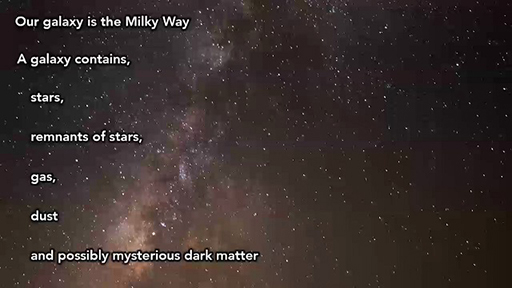2.2 The Milky Way
This video describes our Galaxy (the Milky Way) and another nearby galaxy, Andromeda. The distances describing their size are measured in light-years (abbreviated to ly), and the timescales describing their movement in millions and billions of years. Here, to appreciate the size of a light-year, you will convert some of these distances and durations into standard SI units and generate some very big numbers in the process!
While watching the video, record the following information to use in the questions that follow:
- the definition of a light-year
- the diameter of the Milky Way and the time it takes to rotate once
- the examples of elements produced in smaller stars
- the distance from the Milky Way to Andromeda, and the time it is expected for the two galaxies to collide.

Transcript: The Milky Way
To convert from millions and billions of years to seconds, which are the SI units of time, you first need to calculate how many seconds there are in a year.
Question 1
If you consider a year to have 365.25 days (to account for leap years), how many seconds are there in a year? Give your answer to three significant figures.
Question 2
The smallest size scale of the scale comparator tool states that the speed of light in a vacuum is approximately 3.0 × 108 m s−1. Use the definition of a light-year from your notes, together with your answer from Question 1, to fill in the gaps and so calculate how far a light-year is in metres.
Question 3
How wide is the Milky Way? Use your calculation of the length of a single light-year, together with your notes from the video, to convert the diameter of the Milky Way from light-years (ly) to metres.
Discussion
These numbers are huge, and it is not surprising that scientists prefer to use light-years rather than metres to describe distances in space.
Question 4
Question 5
In other sections of the size–time explorer you learn about photosynthesis, which is the fixing of carbon dioxide (CO2) into carbohydrates using light as energy. Complete the following paragraph, which describes how stars are the source of the components of this reaction described above.
Question 6
The video introduced another galaxy, Andromeda, which is 2.5 million light-years away. Researchers predict that the Milky Way and Andromeda galaxies will collide in about 4.5 billion years.
Use the calculations above as a model to convert this distance and time to SI units then add the bar ‘Milky Way collision with Andromeda’ to the size–time explorer [Tip: hold Ctrl and click a link to open it in a new tab. (Hide tip)] . (You may want to open the explorer in a new tab in your browser, for ease of reference back to these questions.)
Summary
In this section you learned about our Galaxy, the Milky Way. By converting light-years (a measure of distance based on the speed of light) into metres you made calculations with very large numbers. Using these big numbers allowed you to gain an appreciation of the size of galaxies and why scientists use alternative units when scales are very large. (The same occurs at very small size scales.)
Stars are the most visible component of a galaxy in comparison to star remnants, gas and dust. They release light and form elements, which are fundamental to life on Earth.
Next: Take a look at the Universe now, but you can also return to the size–time explorer and select a level for yourself, or use the ‘Next >’ button to go to the next level down on the size scale.
